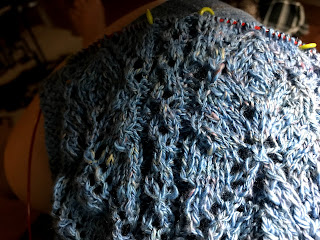I'm working on this Japanese knit pattern from Deborah
Tomasello--I think I'm addicted to this way of knitting.
You get cables without a twisting the stitches, you get lovely motifs
I'm using my handspun cotton with size 6 needle.
Pattern Cowl #46, 104--This is so much fun to knit--
I've put off knitting other patterns just to sit and do this!
I'm getting a very lacy look with the size 6 needles so I
decided to go down to #2 to see what happens.
By using #2 size needles, I'm getting a much closer knit and
I think I like the look
Notice the cable running up the middle--The question was
asked "What makes this Japanese knitting?"
1--Unlike the western use of written instructions, the Japanese use symbols and graphs for all of their knitting and crochet patterns. This means that their patterns can be read universally with no language barriers.
2--twisted stitches, manipulated stitches, wraps… where the ‘stitch’ may take several rows to be realized. Also, the Japanese knit cables have special patterns in and around, more so than more common cables with say, reverse st st around.
3--The Japanese interpretation of knitting stitches.” Many of the stitches are similar to other stitches found in Western stitch encyclopedia’s, however, in many cases, the finished product looks just a little bit different than others. This is also the case with Estonian knitting. The Japanese tend to use mock cables to a much greater extent than most, and, often in a slightly different way, so that they create a “texture” look










No comments:
Post a Comment